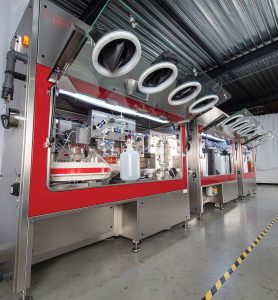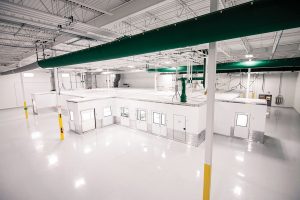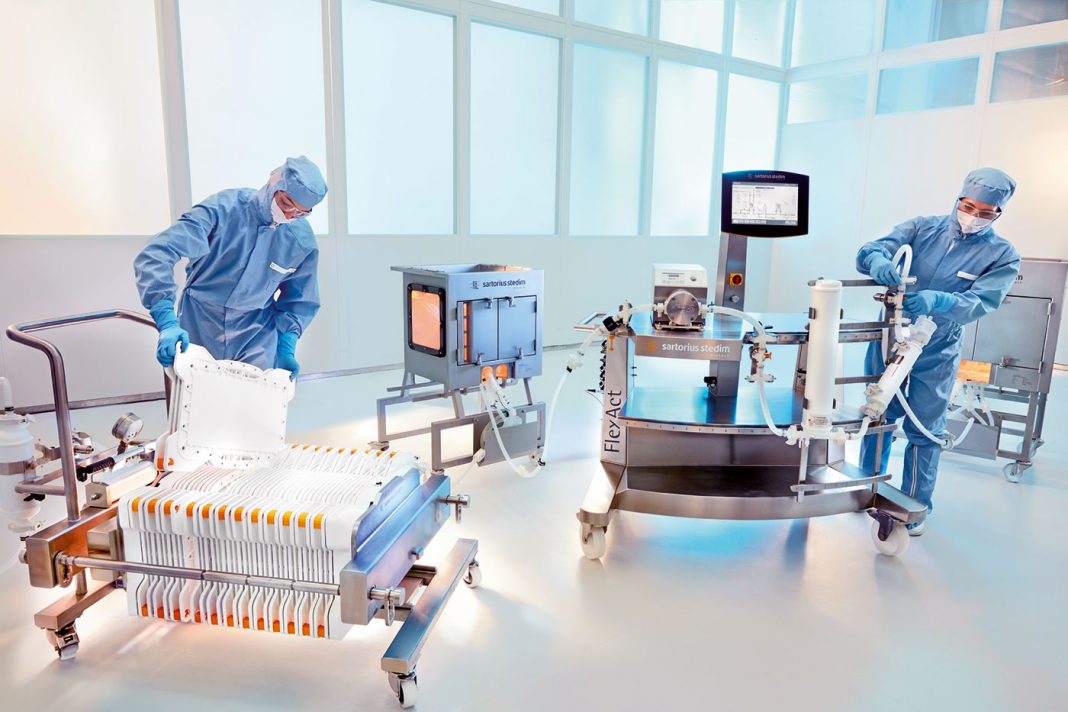Instead of building a traditional fixed factory of rooms and areas dedicated to specific steps in bioprocessing, companies can opt for a modular approach. From upstream to downstream—all the way to out the door—companies can build up a bioprocessing line from individual pieces that cover all of the steps: media preparation, cell culture, purification, compounding/formulation, and fill/finish. Today’s bioprocessors can implement modular systems in various formats and achieve gains in speed, flexibility, and more.
“The scale of the modularity can vary between different users; however, it is generally perceived that modular manufacturing relates to an assembly of preconfigured processing elements, each with a finite, but not necessarily inflexible, functionality,” explains Morgan Norris, vice president of marketing at Pall Biotech (Port Washington, NY). “These modular elements can be as small as single-unit operations, or can themselves be combined to form more complex, but no less standardized, integrated processing elements.” He continues, “The same definition can also extend to cover entire processing solutions contained within preconfigured facilities.”
This is a bit of a LEGO® brick-like solution to bioprocessing, where a set of specific prefabricated parts can be combined in a huge variety of ways. Certain configurations could facilitate the production of therapeutic monoclonal antibodies (mAbs); different configurations, the production of other molecular products. Like the LEGO® system, modular bioprocessing includes many simple and standard pieces, as well as some custom ones.
Applying single-use technology
Many aspects of the pharmaceutical industry move fast, and that’s no less true of the biopharma field. “Biomanufacturing is looking for products that can address their needs today as well as adapt to the changing needs that new technologies or business dynamics may bring in the future,” says Neil Ross, senior global product marketing manager,
GE Healthcare, headquartered in Chalfont St. Giles, UK. “Single-use has transitioned from an interesting concept to the standard in biomanufacturing, and it is now the foundation for most bioprocessing equipment.”
When pieces for single-use bioprocessing are selected, more than the modules themselves must be considered. “When a bioreactor is purchased, it is more than just that piece of equipment that influences the selection,” Ross explains. “The single-use expendables, automation, technical support, lifecycle support, and global supply chain are all criteria that can contribute directly to the decision.” In considering a bioreactor, such as GE Healthcare’s Xcellerex, companies should consider the cell culture media, scalability, and process development support that comes with a bioreactor.
The modular approach depends on the best combination of technology and instruments. Many companies want approaches that provide flexibility and improve speed. “The biggest reduction in time to market can be realized utilizing parallel pathways, combining process development efforts that optimize single-use technologies with predesigned modular facilities,” says Michelle Stafford, global product marketing manager, enterprise solutions at GE Healthcare.
Gaining flexibility
Like other vendors in the modular market, Sartorius Stedim Biotech (Göttingen, Germany) offers various platforms. One of these is FlexAct, which is a single-use system that can be configured as needed. “The FlexAct-based modular skid provides maximum flexibility to control six different upstream and downstream operations using process skids for buffer and media preparation, cell clarification, crossflow filtration, virus inactivation, and virus filtration at processing volumes ranging from pilot scale to commercial scale—2000 L,” says Ganesh Kumar, global technology consultant for intensified and continuous biomanufacturing at Sartorius.
The key to a FlexAct-based system is flexibility, plus the range of what such a system can do. “Where applicable, multifunctionality can be introduced into a FlexAct, thereby eliminating the need for dedicated process skids for unit operations,” Kumar explains. “This subsequently brings modularity on a process level and also on a facility level by lowering the cleanroom footprint and maintenance costs.”
In many modular setups, company leaders think about what the system can do today, and how it can be used tomorrow. That tomorrow might mean years ahead or even just a day or two in the future. The latter arises where a company uses some common equipment to make different biopharmaceuticals. In those situations, changing over the setup comes into play.
“The multifunctionality of the FlexAct—the modular hardware and automation—enables customers to considerably reduce the time and the effort needed during product changeover,” Kumar asserts.
To execute a product changeover or implement another modification in a bioprocessing system as easily as possible, companies need a control center, especially if the system comprises interacting modules.
Having it both ways
Many companies involved in bioprocessing—research and development labs, contract manufacturing organizations (CMOs), and others—work with various products. Modular methods can come in handy here. “Modular manufacturing may ease multiproduct manufacture as different modules can be assembled together according to the needs of the target product,” says Tania Pereira Chilima, EngD, product manager at Univercells (Gosselies, Belgium). “This is specifically important to CMOs catering to different customer projects.”

Univercells’ NevoLine platform can be used for that very thing. Chilima describes the NevoLine platform as “a modular and automated manufacturing system delivering affordable viral products, such as vaccines and gene therapy vectors.”
This system can be designed for different products produced at different scales. As an example, Chilima points out that “viral-vector-specific NevoLine platforms can be designed for adeno-associated virus or lentivirus manufacture for small- and large-scale applications.”
The space required to get something done also matters in many operations. Keeping a bioprocessing platform’s footprint small depends on several factors. At the core of the NevoLine platform lies the scale-X fixed-bed bioreactor coupled with in-line product concentration to intensify upstream processing and deliver large product quantities within a reduced footprint, as Chilima describes it. “Intensification of each unit step,” she notes, “allows for drastic footprint reduction, enabling the entire process to be placed in self-contained modules, such as isolators or biosafety cabinets.”
A small footprint and intensified processing is a valuable combination in various markets. As an example, Chilima notes that a second manufacturing concept from Univercells “will enable cost-effective biotherapeutics production in low-volume markets.”
Incorporating PODs
A bioprocessing system’s builders not only need equipment, they also need a place to put it. Instead of creating and fitting out space for new instruments and processes, companies can buy complete modular cleanroom areas that can be prefabricated offsite and then installed in a manufacturing facility. Headquartered in College Station, TX, G-CON Manufacturing helps companies do exactly that with its PODs, which the company describes as “prefabricated containment cleanroom systems.” A POD can be customized for a variety of applications, from creating mAbs to fill/finish. Upon delivery, the company just connects power and basic utilities and a POD is ready to roll.

One of the reasons companies pick G-CON’s PODs has to do with speed. “Our PODs,” says Dennis Powers, vice president of business development and sales engineering, G-CON, “provide the ability to design and build a facility much faster than traditional construction, which follows a more sequential approach.” With the company’s PODs, different elements of a bioprocessing line can be developed and built in parallel. “That compresses the timeline,” Powers emphasizes.
As an example, G-CON created PODs for a new Just Biotherapeutics facility in China. Here, the G-CON PODs constitute a 500-L mAb manufacturing facility. In a typical G-CON project, Powers notes, the company is involved “from engineering design through site acceptance testing and qualification of our PODs.”
The team at G-CON has developed standard POD designs for various applications, but the structures can be adapted as needed. “We try to stay as close as we can to the standard to keep a project economical and complete it quickly,” Powers relates. Although the actual time savings depends on the project, in some cases, Powers asserts, G-CON can cut the project timeline by 50% compared to traditional construction.
Beyond providing time and cost savings, prefabricated options make it easier to change the scale of an operation. Another example is the KUBio line of prefabricated facilities from GE Healthcare for creating mAbs. “The next KUBio offering,” Stafford says, “will address the unique needs for production of viral vectors with a smaller, biosafety level-2 design and distinct production environment.”
Managing modularity
In modular bioprocessing, a company accepts the challenge of working with lots of moving parts. This succeeds as an overall process only if all the parts work together under the guidance of a module-managing mind of some sort.
The needed control depends on what is being combined, and it must fit the scale of the operation. “The scope of modularity is the largest variable,” Norris says. “Pall Biotech delivers a wide range of modular solutions, and the scope can vary from complete end-to-end processes to simple combinations of individual steps to work with existing process equipment.”
Pall Biotech modules include Allegro STR single-use bioreactors, the Stax mAx clarification platform, Allegro single-use chromatography systems, and the Cadence Virus Inactivation system. “From a modular perspective, the key benefit across all these—and similar—products is that they perform across a wide range of process scales and process conditions,” Norris explains. “Without this, any inclusion in a modular platform is inherently limited to a narrow range of process conditions and scales.” Another benefit of these modules, he asserts, is that they work together.
“Communication and connectivity highlight a key future trend,” Norris states. “The automation of multiple modules through a centralized system adds a layer of control and reliability and takes us another step closer to the next generation of bioprocessing.”
In reaching for that next generation, the entire biopharmaceutical industry hopes
to find more efficient and more flexible approaches to manufacturing medicines. Modular methods ensure that companies can adjust as fast as possible in an ever-changing medical industry.


